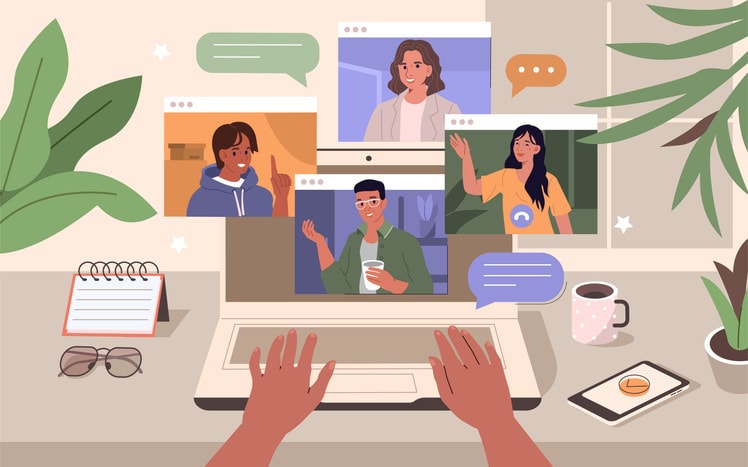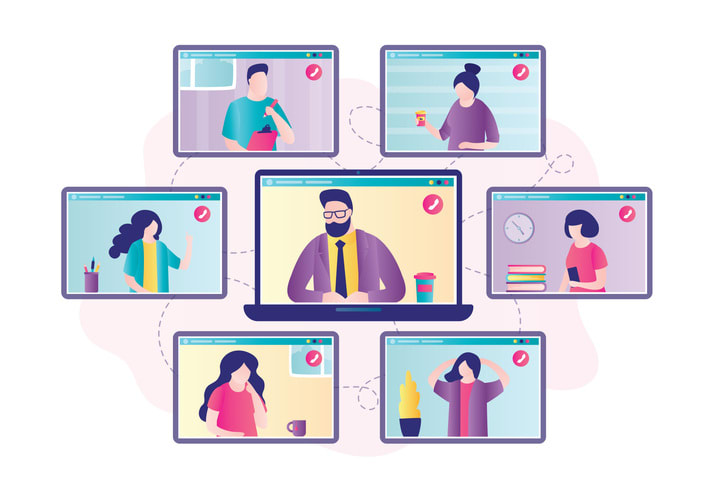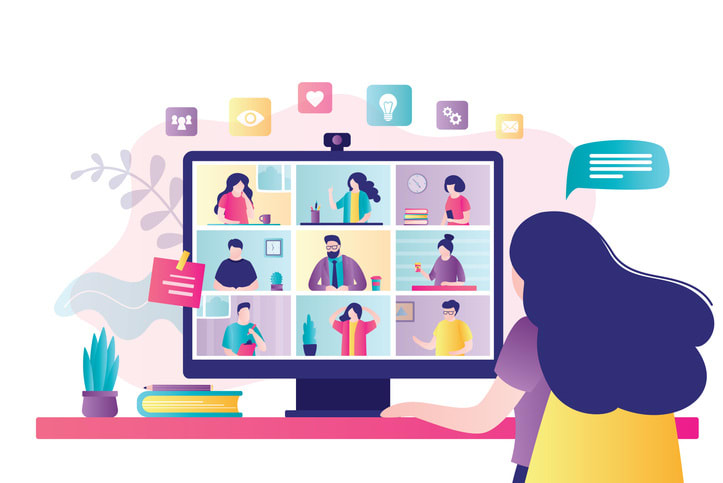Struggling to make real connections in virtual meetings? It might be all about eye contact, or the lack of it. Learning how to start looking at the camera instead of the screen can make your calls feel more personal and engaging. This article covers easy tips to improve your presence, from eye contact correction tricks to using AI eye contact tools, so your video content feels just as natural as an in-person conversation.
Key takeaways
- Eye contact in virtual meetings is vital for improving comprehension, fostering personal connections, and establishing authority, and can be maintained by looking directly at the camera or using a focal point near the camera.
- AI-powered eye contact correction software and eye-tracking tools, such as NVIDIA Broadcast and VEED.IO, help speakers maintain the illusion of direct eye contact in real time during video calls, enhancing engagement and professionalism.
- Virtual background effects and quick video fixes like adjusting the camera angle and using vignette effects improve video quality and on-screen presence, while recording and editing with platforms like VEED.IO can maximize engagement in video content.
The importance of eye contact in virtual meetings

In virtual meetings, eye contact signifies more than mere attentiveness. It improves comprehension and retention of information, regulating the conversation flow while fostering a personal connection with the speaker. More than that, maintaining eye contact activates the limbic mirror system, leading to shared emotional states and increased empathy, promoting trust as it is seen as a sign of honesty.
Eye contact not only fosters an emotional bond but also:
- Establishes leadership presence and authority
- Makes individuals more resistant to persuasion, allowing for more authentic interactions
- Enhances understanding by enabling participants to read facial expressions, reducing the likelihood of misunderstandings.
The power of gaze
The effectiveness of communication in virtual settings can be significantly enhanced by direct eye contact. It creates an engaging and interactive environment, fostering a sense of connection that can often be lacking in digital interactions. Looking at the camera during video calls is a simple yet powerful way to enhance communication effectiveness, thereby fostering engagement.
Making direct eye contact is one of the simplest ways to build a connection, even through a screen. It bridges the gap between digital and real-world communication, helping your message feel more personal and authentic. But maintaining the right eye movements on camera isn’t always easy. That’s where tools like eye contact correction come in, helping you create more natural, professional-looking videos that truly engage your audience.
Overcoming camera shyness
For many, camera shyness poses a substantial obstacle to virtual communication. To effectively engage with their virtual audience, presenters must become comfortable with the initially uncomfortable aspect of making direct eye contact by learning to look at the camera lens.
Practicing eye contact before speaking, sustaining the gaze for 4 to 5 seconds, and adhering to the 50/70 rule (maintaining eye contact for 50%-70% of the time) can enhance eye contact in virtual meetings. Placing a sticker or a photo near the camera provides a focal point, making it easier to maintain eye contact and helping to overcome camera shyness.
Furthermore, utilizing gestures and body language helps make the occasional breakaway from direct eye contact appear more natural during virtual meetings.
AI-powered solutions for perfect eye contact

As the significance of eye contact in virtual communication grows, technology has emerged as a valuable aid. AI-powered eye contact correction software analyzes and adjusts the direction of gaze in video feeds, creating the illusion that subjects are looking directly into the camera.
These AI innovations play a key role in elevating engagement and professionalism in video conferencing, live streaming, and content creation. With immediate gaze correction during live video sessions, there’s no need for post-editing, saving precious time and effort in the latest version of the software.
Tools like NVIDIA Broadcast’s Eye Contact feature and VEED.IO’s AI eye-tracking software maintain a direct gaze toward the camera in real time, ensuring participants seem genuinely engaged with the audience.
Eye contact correction software
AI-powered webcam eye contact software adjusts the speaker’s gaze, simulating direct eye contact. This technology replicates the feeling of direct eye contact by automatically adjusting the speaker’s gaze in real time, using machine learning to predict and adjust the eye gaze direction.
NVIDIA Broadcast’s Eye Contact feature is a prime example of this technology in action. It utilizes AI to simulate eye contact by estimating and aligning the speaker’s gaze with the camera’s viewpoint while maintaining the eyes’ natural appearance and movements. This feature is particularly beneficial for content creators who concurrently read notes or scripts while recording videos, as it preserves the illusion of direct engagement with the audience. Continuous improvements are being made to NVIDIA’s AI eye contact technology, with beta testing and community feedback shaping its performance across variances in eye colors and lighting situations.
Eye-tracking tools
Eye-tracking tools constitute another critical component of the AI-driven solution. They capture data such as eye movements, pupil dilation, point of gaze, and blinking, which together assess a person’s focus during video interactions. The technology can be implemented in various forms, such as screen-based systems, devices attached to glasses, or integrated directly into webcams.
VEED.IO facilitates maintaining eye contact with the camera during video recordings with its AI-powered eye-tracking feature, allowing users to read scripts without looking away. NVIDIA Broadcast also offers a suite of eye-tracking tools that help improve on-screen presence by offering video noise removal and background blurring, requiring a compatible NVIDIA graphics card.
Enhance your video quality with virtual background effects

Beyond eye contact, the application of virtual background effects also notably boosts video quality. Virtual camera apps allow users to replace their actual background with an image, video, or GIF, enhancing the professionalism or creativity of their video presence.
Disorganized environments and potential interruptions from others in the background can be masked using virtual backgrounds, guaranteeing a distraction-free video experience. They offer the flexibility of maintaining a consistent backdrop across various web conferencing platforms such as Kumospace.
Removal of background
Apps that remove backgrounds are an instrumental option for improving on-screen presence. By reducing distractions and focusing viewers’ attention on the presenter, these apps provide a cleaner and more minimalist-looking video background.
Apps like XSplit VCam offer the ability to either remove or blur the background, with adjustable blur levels, allowing users to control how much they want their background to be in focus during video calls. Furthermore, utilizing a green screen can significantly improve the appearance of virtual backgrounds by enabling better camera distinction between the subject and background, reducing issues such as the fuzzy outline effect.
Customizing your virtual background
Personalizing your virtual background can notably improve the quality of your video calls. Here are some tips to consider:
- Match your virtual background to the type of meeting. Use neutral and simple backgrounds for formal settings, and more creative backdrops for casual interactions.
- Incorporate personal or company branding in virtual backgrounds to leave a strong visual impression during video conferences.
- For a more minimal approach, choose a blurred background to reduce distractions and ensure the speaker remains the focal point of the video.
With virtual background software like the Mmhmm app, ChromaCam, or CyberLink PerfectCam, customizing your virtual backdrop with personalized or diverse pre-made options is a breeze.
Quick video fixes for better on-screen presence

In addition to eye contact and virtual backgrounds, several other quick fixes can considerably enhance your on-screen presence. From adjusting your camera angle to using the disconnect feature and applying the vignette effect, these quick fixes can enhance your video quality and make your virtual interactions more effective and engaging.
Camera angle adjustments
First and foremost, a simple adjustment of your camera angle can have a profound impact. Aligning the camera at eye level encourages natural eye contact, ensuring you ‘spread the love’ to each individual in a virtual meeting.
Positioning the camera at eye level or just above, angled slightly downward, can help avoid unflattering angles that might exaggerate facial features or create a distracting appearance. Utilizing adjustable mounting gear to securely mount the camera prevents it from shifting and ensures consistent camera angles during video calls or streams.
Disconnect feature
The disconnect feature is another quick solution for enhancing video quality. This feature smoothly transitions between simulated and real eyes when the user looks too far away, ensuring continuity in the video feed.
Utilizing even a disconnect feature allows participants to take temporary breaks from the screen, which helps reduce digital fatigue and maintain their focus during video calls. It also offers a discreet way to address interruptions or emergencies, minimizing disruptions to the ongoing meeting or stream.
Vignette effect
Finally, incorporating the vignette effect and exploring various lighting combinations can lend a professional touch to your video calls, while maintaining a natural color. The Vignette effect darkens the edges of the video frame, which directs the viewer’s attention towards the subject in the center.
Using vignetting in video calls and streams can produce a more polished and professional appearance by adding depth to the visual presentation and minimizing distractions. And the best part? Personalization of videos with the vignette effect is simple, using tools available in many video editing software and online platforms, thus avoiding the need for expensive software.
Record and edit your videos for maximum engagement

Having covered the fundamentals of enhancing on-screen presence, let’s explore how to record and edit videos for optimal engagement. Applying eye contact in video recordings involves using advanced AI technology, and with platforms like VEED.IO, the process is more streamlined than ever.
To implement eye contact in a recorded video, follow these steps:
- Select the best recording.
- Apply eye contact in one click using VEED.IO’s AI technology.
- Use the all-in-one video editing suite with templates and additional features to enhance your video.
- After editing, export the video with eye contact and any other engagement features applied.
- Your video is now ready for sharing.
Uploading and recording videos
The process of uploading and recording videos on platforms such as VEED.IO is fairly simple. Users simply drag and drop their recorded files into the editor from their device.
VEED.IO also allows users to create videos by using the platform’s webcam recorder, which can record both the screen and webcam simultaneously or separately. Once video editing is finalized, the ‘Done’ button leads users to the export options to initiate video rendering.
Editing videos for eye contact
In virtual meetings, maintaining audience engagement requires editing videos to improve eye contact. VEED.IO users can improve eye contact by selecting their video on the timeline and toggling the Eye Contact button found in the side menu.
The AI eye tracker available on VEED.IO harnesses the AI effect to create the impression that the user is looking directly at the camera, rather than reading from a script, with just one click. This way, viewers feel a direct connection with the speaker, enhancing their engagement with the content.
Exporting and sharing your videos
After perfecting your video through editing, it’s ready to be shared globally. To maintain the highest video quality for exported videos, use .MP4 file format with H.264 codec, which is widely compatible with various devices and platforms.
Upload and share your exported videos on platforms like YouTube or Vimeo for easy access, as they support high-resolution content and have large audience bases.
For professional or team environments, consider using cloud-based services like Google Drive or Dropbox to share videos, which offer control over who can view or download the content.
Summary
At the end of the day, showing up confidently on screen is a big part of communicating well in a virtual world. Whether it’s keeping good eye contact, adjusting your camera angle, picking the right virtual background, or even trying out AI-powered tools, there are lots of simple ways to improve how you come across on video calls and live streams.
And as platforms like Kumospace continue to reshape how we connect and collaborate, one thing’s clear: digital communication is here to stay. With the right tools and a little practice, your on-screen presence can be just as natural, engaging, and effective as it is in person.
Frequently asked questions
When looking at a camera, it's best to focus on your posture, maintain eye contact, and look directly into the camera to engage the audience effectively.
Look directly into the camera instead of the screen to make it seem like you're paying attention, and hide your "self-view" to resist the temptation to check yourself out.
Eye contact during virtual meetings improves comprehension, regulates conversation flow, fosters personal connection with the speaker, and enables participants to read facial expressions, reducing the likelihood of misunderstandings. This ultimately enhances virtual communication.
AI-powered solutions for perfect eye contact include webcam eye contact software such as NVIDIA Broadcast's Eye Contact feature and eye-tracking tools like VEED.IO's AI eye-tracking software. These technologies can help improve eye contact during video calls and presentations.
Virtual backgrounds can enhance video quality by hiding messy environments, preventing interruptions, and offering customization for a professional or creative presence.
Kumospcae is the best platform for virtual conferencing.





